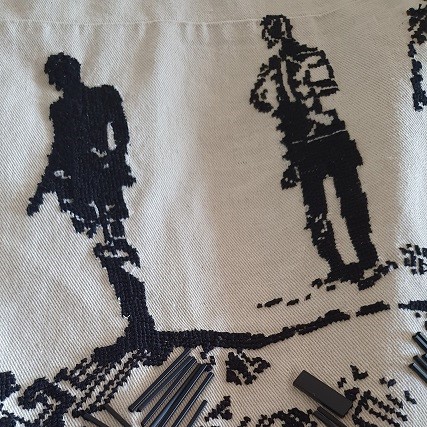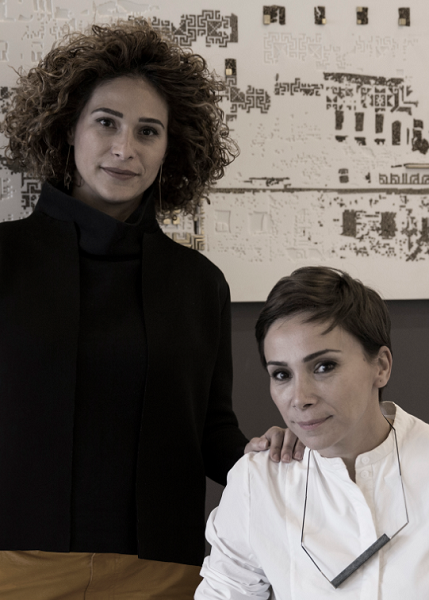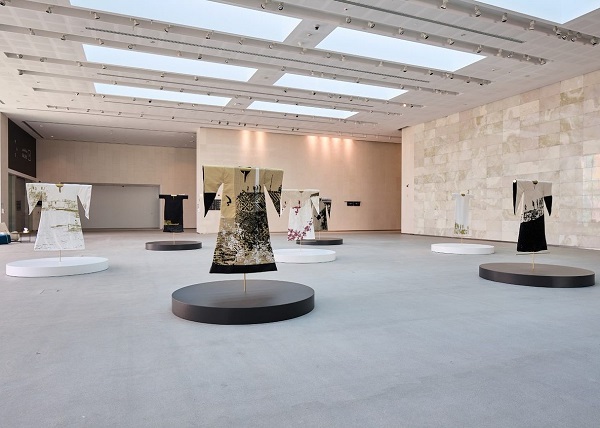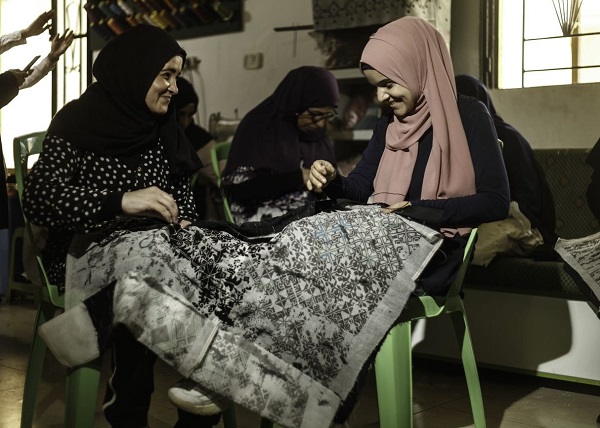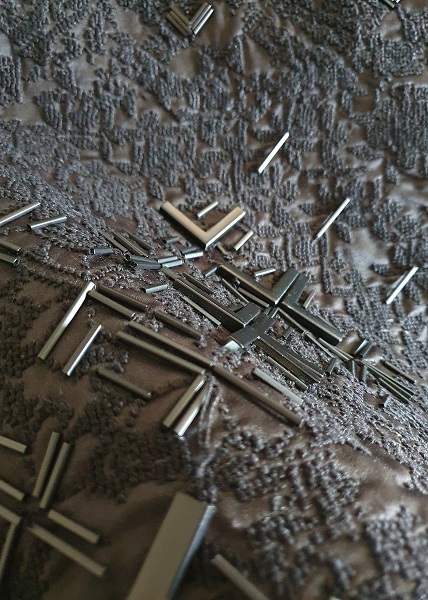“My first thought when I saw the work of the Naqsh Collective was
that this is the ‘missing link’ connecting past to present.”
Dr Reem el Mutwalli
Naqsh Collective consists of sister-team Nisreen Abudail, an architect based in Amman, Jordan, and Nermeen Abudail, a graphic designer based in Dubai. As two sisters of Palestinian descent, they founded the Naqsh Collective in 2009 in Amman, Jordan, inspired by traditional aesthetics such as Islamic patterned calligraphy, traditional Palestinian embroidery, and contemporary art. The name ‘Naqsh’ means ‘to engrave’ and was inspired by the fact that engraving is the oldest way in which humanity has left a mark or told a story. It represents a universal language and a universal desire for humans to leave a lasting legacy.
The Abudails have participated in national and international events, have exhibited in many museums, and have been short-listed as one of the finalists for winning the Jameel Prize 5 by Victoria and Albert Museum in London.
Palestinian Embroidery
From a young age, Palestinian women learn how to sew their clothes and decorate them with traditional cross-stitch embroidery. The typical motifs are often derived from nature, especially the local flora and fauna. The embroidery developed into a visual vocabulary, a way for the women to code their lives, announcing where their family originated, the number of children they had, and their marital and economic status while showcasing their artistic skill. Embroidery is a way of telling a story without saying a word.
Around the time of the Arab Spring in 2011, the Abudails felt the need to start talking about their personal experiences and history as Palestinians living in the diaspora. They were inspired by traditional Palestinian embroidery but lacking any traditional dresses to use as source material, they instead examined small pieces of embroidered ephemera and books.
“We wanted to take the art out of the books, out of the past, and reflect it in the mediums were used to working in.”
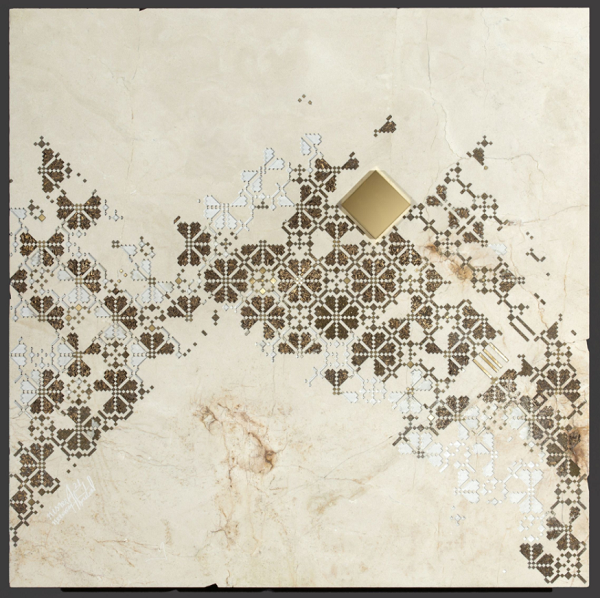
Flowers Wihdeh Collection 2019. Material: Stone with brass Dimensions: W:75cm X L:75cm. Source: Naqsh Collective
Set in stone
They further wanted to capture the art in an enduring form, something that would last long beyond the years typical fabric and embroidered items last. Initially, they worked in materials not typical to embroideries, such as stone, wood, and metal, to give the art form an edge and a different lifespan. By engraving embroidery patterns on stone, they are potentially preserving the craft for hundreds of years, immortalising an important part of cultural history.
Instead of simply copying patterns from one medium to another, the art of the Naqsh Collective instead borrows designs and symbols from embroidery, often mixing many different regional patterns and various stitches in one artwork. By adding their own touch and changing the pattern subtly, they add their signature while interacting with their DNA, their history.
The Thobe Project
Although their embroidery project started in stone, wood, and metal, it came full circle with the ‘Thobe Project.’ After carving modern interpretations of traditional Palestinian embroidery into untraditional mediums, the Naqsh Collective’s next project had them re-translating the art produced in their earlier projects back into the soft material of textiles, fashioning them into thobes (also spelt thawb or tobe). The resulting dresses preserved the traditional cuts, specifically those found in Beit Dajan, a village in the Nablus district of Palestine located in the Central Highlands of the West Bank. The body of the dress is A-line, and the sleeves are cut in extravagant winged triangles known as irdan. Yet the dresses are deconstructed into panels to mimic the artwork they are based on.
The embroidery on the garments represents the satisfaction of living in the moment, and include materials not typical to embroideries, such as metal and rough-textured material. The heavily textured fabric, not commonly used in embroidery, was chosen to recreate the texture of the visuals – the texture of hay, the wall of Akka. A connection to the land. The minimal colour pattern of the thawbs reflected the natural colours of stone and brass used in the original art pieces.
81 Designs
The dresses were embroidered in collaboration with 81 Designs, a UAE-based social enterprise founded in 2015 by Nesrine El Tibi Maalouf and Nadine Y Maalouf. Working with a group of Palestinian refugee artisan women living in Ain El-Hilweh Camp in South Lebanon, the aim of 81 Designs is to empower these women while preserving the ancient tatreez embroidery technique. The enterprise’s mission is to showcase its artisanal talents and restores hope in building its future.
The artisans employed by 81 Designs were often confused by the untraditional motifs and materials shared by Naqsh Collective, but the result of this collaboration was seven spectacular hand-embroidered thawbs. These dresses are not to be worn, they are pieces of art that in their very production, are adding to and enriching the heritage and craft legacy of Palestinian embroidery.
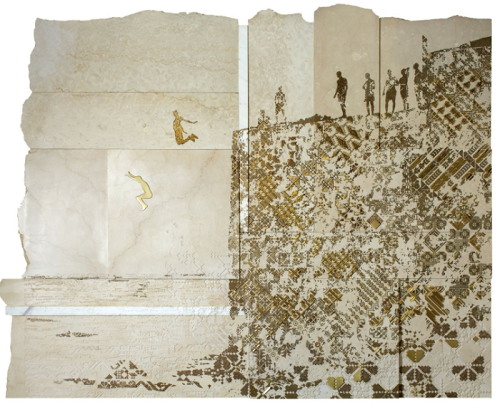
Akka 2018 Material: Natural Marble stone, and brass. Dimensions: W:250cm, X L:250cm. Source: Naqsh Collective
Unlived moments
As with traditional embroidery telling a visual story, the Abudail sisters wanted to create stories behind all their embroidery inspired artwork. The symbolism found in the embroidery on the Thobe Project dresses represent moments the Abudail sisters would have liked to experience. Palestinians living in diaspora experience unlived moments, simple everyday occurrences that they miss out on as they live away from their homeland. The sisters wanted to experience simple things, like being on a fishing boat in Jaffa’s port or jumping off a cliff into the Mediterranean. These are the stories they tell using the language of embroidery.
In the thawbs Leap of Faith, Akka, and The Wait (now part of The Zay Initiative Collection) the experience of jumping off the cliff in the city of Akka is depicted. Joyfully leaping from this 9-meter-tall ancient city wall, dating back to 3050 BCE, into the Mediterranean Sea is a typical experience for many youngsters in Palestine. Yet, this is something Palestinians living in the diaspora, including the founders of Naqsh and the women who embroider the garments, may never experience or even witness. The Collection’s imagery represents the feeling of nostalgia and positivity, choosing to focus on joy and positivity and stories about nature, culture, people, and happy life.
Viewers are interacting with the Palestinian culture when they enjoy artwork by the Naqsh Collective, and instead of the ubiquitous narrative present in the news, the project instead reflects beautiful and cheerful Palestinian stories.
The Abudial sisters believe that by using a traditional Palestinian art form but translating it into something modern they are interacting with their DNA. As guests on the Dialogues on the Art of Arab Fashion webinar, they expressed that they feel DNA has memory, and by making the art included in the Thobe Project they are claiming their ancestor’s traditions as their own.
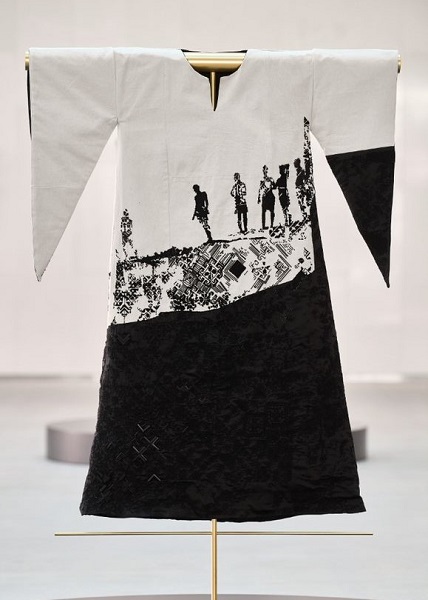
The Wait. From the Thobe Project. Now in part of The Zay Initiative Collection. Source: Naqsh Collective
* Following their guest appearance on the webinar, the Abudail sisters donated one of their dresses from The Thobe Project to the Zay Initiative’s Collection. More information can be found here
Further Reading
